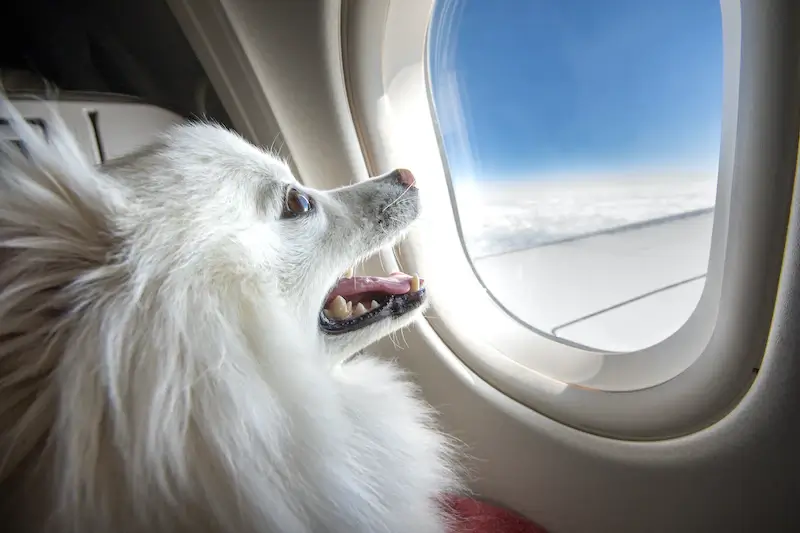Traveling with your four-legged friend can be exciting. Showing your dog the world is a fun addition to any travel plans. However, it’s important to know that several dog breeds are banned on airlines. There are no universal rules for what breeds are allowed. However, there are quite a few breeds that are typically banned from top U.S. airlines.
In addition to breed bans, there are often weight and age limits. For example, to travel within the U.S., puppies must be at least 10 weeks old. If traveling internationally, your dog must be at least 16 weeks old. Typically, a dog under 20 pounds will be eligible to travel in an appropriately sized carrier. While each airline is a bit different, here are a few dog breeds that are commonly banned on airlines.
1. Commonly Stereotyped Dogs
If you’ve ever lived in an apartment complex, you know the difficulty of owning some breeds. Some cities even have breed restrictions. While these breeds are not aggressive by nature, there are stereotypes that permeate society.
For example, pit bulls and rottweilers are often seen as a danger to children and other dogs. Despite the American Canine Temperament Test Society describing these dogs as one of the most temperamentally stable purebreds.
These stereotypes also negatively contribute to fewer adoptions and higher euthanization rates. According to PetPedia, about 40% of all dogs euthanized in animal shelters are pit bulls. Other studies show only about 1 out of every 600 pitties find a forever home. Breeds in this category don’t typically have a legitimate reason associated with their banning on planes, but they still are.
The stereotyping of dogs like cane corsos and chow chows comes from their dominant nature. However, many families successfully have these dogs as a part of their home. Other dogs like miniature pinscher, American staffordshire terrier, and bull terrier are banned from some airlines, too.
Because of this, these dogs are difficult to transport across the country. With fewer airlines accepting these breeds, you may have to get creative. You could try using a pet transport service for your furry friend.
With a quality transport service, you and your pet will have a stress-free experience. Some companies even offer photo and video updates to keep you in the loop during your pet’s travels. This is sure to provide you with peace of mind.
2. Snub-Nosed Dogs
Short-snouted pups are some of the most commonly banned breeds on all airlines. These brachycephalic dogs are predisposed to breathing difficulties. They experience changes in temperature and air quality with greater risk than their longer-snouted friends. These dogs have unique anatomy that makes them more susceptible to breathing problems. Small tonsils, a long soft palate, and narrowed windpipe leave these breeds vulnerable.
Because of this, they are often restricted from traveling in cargo. Choosing to fly your sub-nosed dog via cabin, cargo, or checked baggage can be a tough decision. However some airlines, like United, restrict these breeds from traveling in the cabin. If the dog is overweight, they are even more likely to experience a complication in flight, regardless of their location.
Breeds like Boston terriers, pugs, bulldogs, and boxers are quickly recognized as short-snouted. But did you know that shih-tzus, lhasa apsos, and English toy spaniels are also considered snub-nosed? It can be surprising just how many dogs have limited travel options. Shar peis, affenpinschers, brussels griffons, and even the popular French bulldog are at greater risk for health issues when flying.
3. Large Dogs
If not for health or stereotypes, a dogs’ size alone can create a barrier for their adventures in the sky. Large breeds are often difficult to transport via plane, and many airlines ban larger dogs. This can be true even if you choose to transport them in cargo.
While each airline creates their own policies, there are general guidelines set by the International Air Transport Association. They have determined that your dog’s crate should be sturdy, not collapsible, and leakproof. Your dog should also have enough room to comfortably stand, turn around, and lay down.
Dogs like bull mastiffs and St. Bernards can range from 99-180 pounds, well over the common 20-pound limit. Their counterparts in this category like the presa canario and dogo argentino can fall anywhere within their large range. Caucasian and Kangal shepherd dogs are also very large and expensive to transport via plane. These dogs are definitely not fitting underneath the seat in front of you!
Be sure to check your specific airline to ensure that you are following their guidelines. Your dog could be banned on one airline but not another. For example, while Alaska airlines allows American pit bulls in carry-on, they’re banned at United Airlines. Service dogs follow different rules altogether, so be sure to know your rights granted by the Americans with Disabilities Act.
If your dog falls into the category of a banned breed, consider different options for their travel. There are times when your only option will be to fly. But try a road trip, using a pet transport service, or changing your destination when possible if your pet isn’t welcome along.

